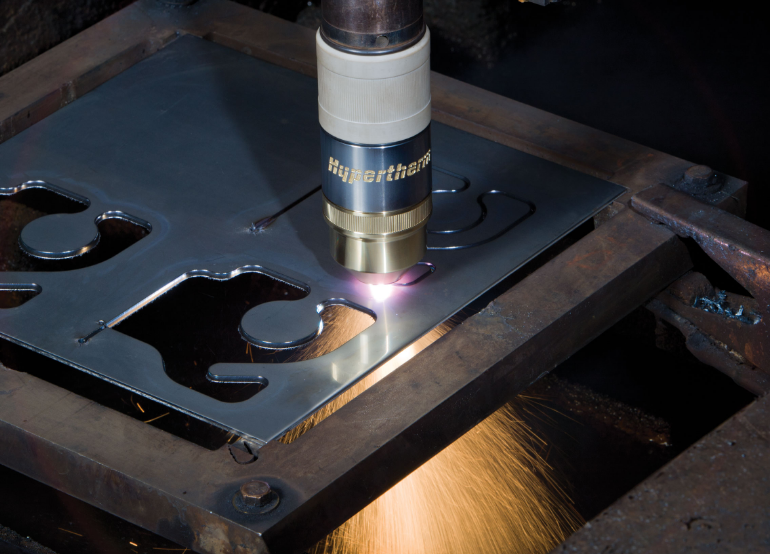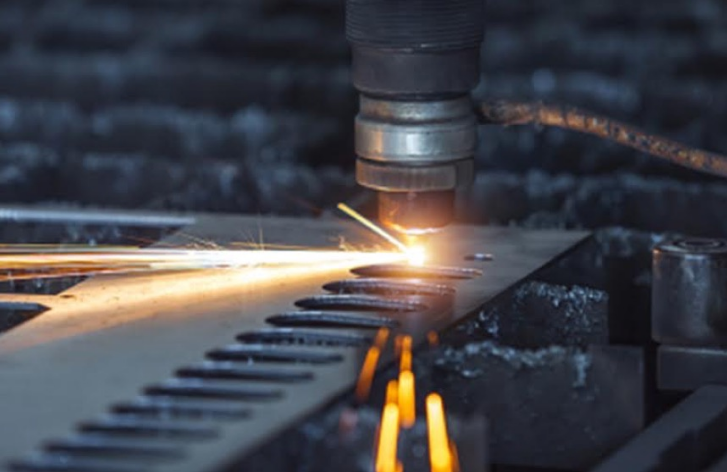Introduction to CNC Plasma Cutting
CNC Plasma Cutting, a technological marvel, seamlessly blends precision engineering with high-efficiency metal cutting. This cutting-edge process, widely recognized for its accuracy, speed, and versatility, revolutionizes how industries handle metal fabrication. CNC, standing for Computer Numerical Control, transforms plasma cutting into a highly precise and automated procedure. This method is pivotal in shaping metals into desired forms with unparalleled precision, making it indispensable in various industrial and creative sectors.
Overview of CNC Plasma Cutting Technology
CNC Plasma Cutting Technology stands out for its ability to cut through various metal types, including steel, aluminum, brass, and copper, with ease and precision. The process involves generating a plasma stream through an electrically ionized gas, which melts the metal at the cutting point. CNC technology enhances this by guiding the plasma torch with computerized precision, ensuring cuts with an accuracy margin of less than a millimeter. This level of precision, combined with the ability to handle metal sheets of up to 50 mm thickness, marks CNC plasma cutting as a highly versatile tool in metal fabrication.

History and Evolution of Plasma Cutters
The journey of plasma cutters began in the 1950s, initially developed to tackle the challenges of cutting stainless steel and aluminum, materials known for their high melting points. Over the decades, these cutters evolved significantly. The introduction of CNC technology in the 1980s was a pivotal moment, elevating plasma cutting into a more refined, precise, and controlled process. Today’s CNC plasma cutters represent the pinnacle of this evolution, offering enhanced capabilities like faster cutting speeds (ranging up to 500 inches per minute), improved energy efficiency, and the ability to handle complex cutting tasks with ease.
The continuous advancements in CNC plasma cutting technology promise even more refined and efficient cutting solutions in the future, further expanding its applications and efficiency in various industries.
Working Principle of CNC Plasma Cutters
CNC Plasma Cutters ingeniously harness the exceptional power of plasma, known as the fourth state of matter. Initially, these machines ignite an electric arc through a gas that surges through a tight opening. The choice of gas varies, spanning from nitrogen and oxygen to argon or standard shop air. Intriguingly, the intense speed and heat of the gas transform it into a plasma state, reaching staggering temperatures up to 20,000°C. This immense heat effortlessly melts the metal, enabling the cutting process.
Basic Mechanics of Plasma Cutting
At the heart of plasma cutting lies the generation and control of a highly concentrated plasma jet. This jet, meticulously focused through a slender nozzle, melts the metal at the target point. Notably, the sheer force of the plasma jet is robust enough to eject the molten metal from the cut, ensuring a neat and precise edge. Power requirements for this process vary notably; plasma cutters typically function within a power range of 12 kVA to 85 kVA. This range is directly influenced by the material’s thickness and the desired cutting speed.
Role of Computer Numerical Control in Precision Cutting
The integration of Computer Numerical Control (CNC) significantly amplifies the precision and adaptability of plasma cutting. CNC enables the pre-programming of intricate cutting patterns and precise dimensions into the cutter’s computer. This advanced control is particularly evident in maintaining a consistent cutter height above the workpiece, usually within a remarkably close margin of 0.5 mm. This consistency ensures uniformly high-quality cuts. Moreover, CNC plasma cutters excel in executing complex and detailed patterns, which manual cutting methods could scarcely achieve. The cutting speeds, varying with material and thickness, can reach an impressive 500 inches per minute, showcasing the extraordinary efficiency of CNC plasma cutters.
Applications of CNC Plasma Cutters
CNC Plasma Cutters have revolutionized cutting processes, finding applications that span from industrial manufacturing to creative arts. These machines bring a combination of speed, precision, and versatility, making them valuable assets in various fields. Their ability to cut through different metals with precision caters to diverse needs, from intricate designs to heavy-duty industrial parts.
Industrial Uses in Manufacturing
In manufacturing, CNC plasma cutters have become indispensable. They are extensively used for cutting large metal sheets, often seen in the fabrication of heavy machinery, automotive components, and shipbuilding. Their ability to handle thick materials, typically up to 50 mm, without compromising on speed or precision, is particularly noteworthy. For instance, in automotive manufacturing, they expedite the production process by rapidly cutting precise parts, maintaining a balance between efficiency and high-quality output.
Creative Uses in Art and Design
In the realm of art and design, CNC plasma cutters offer artists and designers a tool to transform metal into intricate artworks. These cutters enable the creation of detailed and precise cuts that are ideal for sculptural works, decorative panels, and bespoke furniture. The precision of CNC plasma cutters is especially beneficial for artists working on complex designs, where every millimeter counts. Their ability to create fine cuts and intricate details in metal opens a new world of possibilities for creative expression and design innovation.
Materials Compatible with CNC Plasma Cutting
CNC Plasma Cutting stands out for its versatility in handling a wide range of materials. Primarily used for cutting various metals, this technology adapts well to different metal types and thicknesses. Its capability to precisely cut through diverse materials makes it a preferred choice in industries where material versatility is key.
Common Metals and Alloys
CNC plasma cutting systems excel in cutting a variety of metals and alloys. The most commonly cut materials include mild steel, stainless steel, aluminum, brass, and copper. Mild steel, for instance, can be cut with CNC plasma systems up to a thickness of 50 mm, showcasing the machine’s robust cutting capacity. Stainless steel and aluminum, popular for their resistance to corrosion, can also be precisely cut, making them ideal for both industrial applications and artistic creations. The versatility extends to brass and copper, though it’s important to note that reflective properties of these materials require specific plasma cutting settings for optimal results.
Limitations and Material Thickness
While CNC plasma cutters are highly versatile, they do have limitations in terms of material thickness and type. The maximum cutting thickness typically ranges up to 50 mm for mild steel, with thinner limits for harder materials like stainless steel and aluminum. For instance, cutting efficiency and quality may start to diminish when dealing with stainless steel over 25 mm thick. It’s crucial to match the plasma cutter’s specifications with the material’s properties to ensure optimal cutting performance. Additionally, certain materials like wood or plastic are not suitable for plasma cutting due to their inability to conduct electricity and withstand high temperatures.

Advantages of CNC Plasma Cutting Over Traditional Methods
CNC Plasma Cutting, compared to traditional cutting methods, offers a plethora of advantages, fundamentally changing the dynamics of metal fabrication. This innovative approach not only enhances efficiency and precision but also broadens the scope of what’s achievable in metal cutting.
Increased Efficiency and Speed
One of the most significant advantages of CNC plasma cutting is its remarkable efficiency and speed. CNC systems drastically reduce cutting times, enabling faster completion of projects. For instance, while traditional methods might take minutes to cut through a thick metal plate, CNC plasma cutters can accomplish the same task in seconds. This speed is particularly beneficial in large-scale production environments where time is a critical factor. Moreover, the reduced need for manual interventions thanks to CNC automation minimizes the chances of errors and reworks, further enhancing overall efficiency.
Precision and Versatility in Cutting Patterns
CNC plasma cutting is not only fast but also impressively precise. The computer-controlled setup ensures that each cut is exact, consistently maintaining high-quality standards. This precision allows for intricate and complex cutting patterns, which would be challenging, if not impossible, to achieve with traditional cutting methods. The versatility of CNC plasma cutters to handle various materials and thicknesses, from thin sheets to 50 mm thick steel plates, adds to their appeal. This adaptability makes them suitable for a wide range of applications, from industrial manufacturing to artistic metalwork.
Maintenance and Safety in CNC Plasma Cutting
Maintaining CNC plasma cutters and adhering to safety protocols are crucial for ensuring optimal performance and longevity of the equipment. Proper care not only extends the life of the machine but also guarantees the safety of operators, a paramount concern in any industrial setting.
Routine Maintenance and Care
Regular maintenance of CNC plasma cutters involves several key practices. Firstly, it’s essential to routinely check and replace consumable parts like electrodes and nozzles, as they wear down due to the intense heat of plasma cutting. For example, a nozzle might need replacement after approximately 4-6 hours of cutting time, depending on the material and cutting intensity. Keeping the machine clean from dust and metal particles also prevents potential malfunctions. Calibration of the torch height control is another critical aspect, ensuring precise cuts and minimizing the risk of damage to both the torch and the material.
Safety Precautions and Best Practices
Safety in CNC plasma cutting encompasses a range of best practices. Operators must always wear appropriate personal protective equipment (PPE), including safety glasses, gloves, and ear protection. The intense brightness of the plasma arc demands eye protection to prevent arc eye, a painful condition caused by exposure to ultraviolet light. Adequate ventilation is necessary to disperse harmful fumes produced during cutting, especially when working with certain metals like stainless steel, which can release toxic gases. Furthermore, ensuring the work area is free from flammable materials and conducting regular safety training for operators are indispensable for maintaining a safe working environment.
